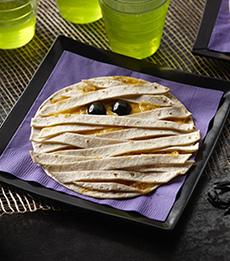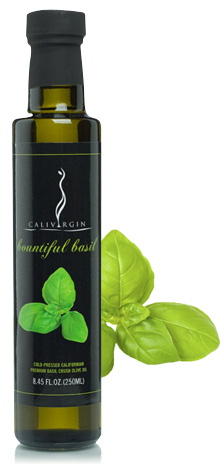EDITOR’S NOTE: WE REGRET THAT THE VIDEO WITH SANDRA LEE HAS BEEN REMOVED BY THE DISTRIBUTOR. WE HAVE REPLACED IT WITH A DIFFERENT HALLOWEEN QUESADILLA RECIPE.
Spooky quesadillas? Sure, and they’re easy-to-make Halloween food—a light dinner for trick-or-treaters or for anyone staying at home who wants some Halloween fun (adults: enjoy them with a pumpkin ale; kids: something creepy green or blood red).
On to the spookadillas!
RECIPE: SPOOKADILLAS (MUMMY QUESADILLAS)
These mummy quesadillas look spookalicious and taste even better. Cook’s tip: If you’re making a lot of these, use a pizza wheel or kitchen scissors to quickly and easily cut the tortillas into strips.
If you like things a bit spicy, sprinkle red pepper flakes over the cheese; or use pepperjack or a jalapeño- or habanero-flavored Cheddar.
We served our quesadillas with a side of crudités: carrot and celery sticks, sliced radishes and bell pepper.
No dip is needed, but you can make an easy dip with plain yogurt and more of the salsa verde* (photo #2).
> Check out the different types of salsa.
Prep time is 15 minutes, cook time is 5 minutes.
Ingredients For 4 Quesadillas
8 flour tortillas (6-inch)
1/2 cup salsa verde*
1 cup finely shredded Cheddar cheese (about 4 ounces)
4 pitted ripe olives, cut in half lengthwise
Olive oil cooking spray (or other vegetable oil spray)
Preparation
1. HEAT the oven to 450°F. Cover a baking sheet or pan with foil or parchment. Place 4 of the tortillas on the sheet. Cut each remaining tortilla into 12 strips, 1/4″ wide.
2. TOP each whole tortilla with 2 tablespoons salsa verde and 1/4 cup cheese. Place 2 olive halves on each for the eyes. Arrange the tortilla strips in a criss-cross pattern over the cheese. Spray the quesadillas with vegetable cooking spray.
3. BAKE for 5 minutes or until the cheese is melted.
BUYING SHREDDED CHEESE VS. SHREDDING YOUR OWN
You’ll often read that grating your own cheese is a cost saver. Yes, but you may be saving just a penny per ounce.
At FreshDirect.com, for example, Kraft shredded cheeses are $4.49 per eight-ounce package, or $.56/ounce. Kraft Cracker Barrel Cheese varieties are $5.49 per 10-ounce block, or or $.55/ounce.
The real reason to grate your own is a broader choice of cheeses. We love the whole variety of Cabot flavored Cheddar cheeses: Garlic & Herb, Horseradish, Hot Buffalo Wing, Hot Habanero, Smoky Bacon, Tomato Basil and Tuscan. The company also makes reduced-fat Cheddars: 50% Cheddar, 50% Jalapeño, 50% Pepper Jack, 75% Cheddar and 75% Habanero, all so good that you’d never guess they were reduced-fat.
To easily grate cheese, we use this OXO Good Grips box grater. It has a detachable container that catches, measures, and stores (with a snap-on lid) the grated cheese.
To those who read ingredient lists: Shredded cheese typically contains anti-caking agents—calcium carbonate, microcrystalline cellulose or potato starch, for example—which prevent the shreds from sticking together. These are natural ingredients, unlike chemical preservatives that some consumers seek to avoid.
HALLOWEEN TRIVIA
Jack o’ Lanterns were not originally pumpkins. To keep away spirits and ghosts on Samhain, people placed candles in their windows, using hollowed-out turnips and other vegetables as the holder.
Get spooked: more Halloween trivia.
________________
*Spanish for “green sauce,” salsa verde is made with tomatillos, green jalapeños or other green chiles, cilantro, garlic, lime juice, ground cumin, salt and pepper. Some recipes add scallions (green onions). Salsa verde is much thinner than a tomato-based salsa roja. A salsa verde can be fresh or cooked. It can be used as a sauce for meets and vegetables, eggs, grains, used as a dip, and of course with Tex-Mex specialties from burritos and enchiladas to refried beans, tacos, tostadas and quesadillas.
|
|

[1] There creepy and they’re spooky: mummy quesadillas (photo © Recipe © Pace Salsa | Campbell’s).

[2] Homemade salsa verde. Don’t panic: store-bought is fine here (photo © Empellón Restaurant | NYC).

[3] Shredded Cheddar. There’s no honor lost if you buy it pre-shredded (photo © Darryl Brooks | Dreamstime).

[4] If you prefer Gruyère or mozzarella, go for it (photo © Kiboka | Panther Media).

[5] Hojiblanca, a delicious black olive variety (photo © Dumet AG).
|









